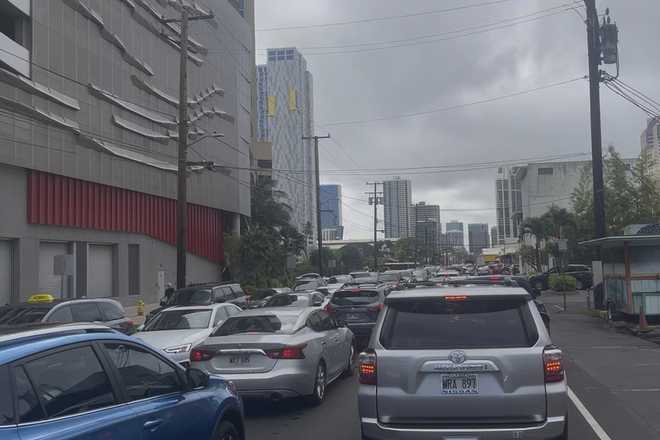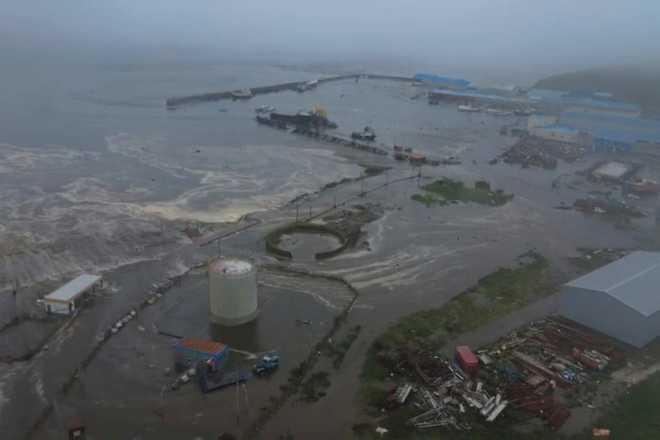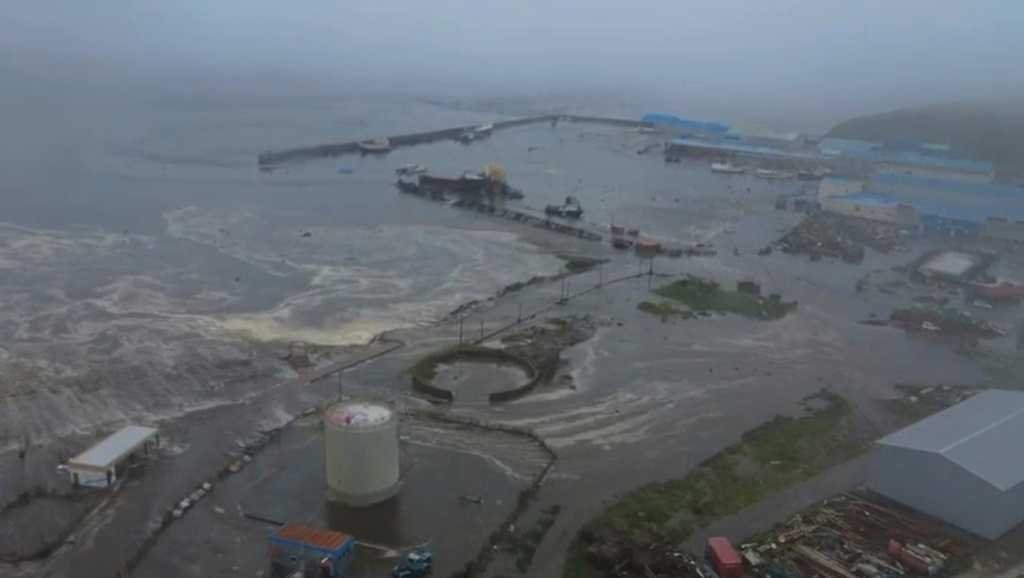One of the strongest earthquakes ever recorded struck off Russia’s sparsely populated Far East early Wednesday, sending tsunami waves into Japan, Hawaii and the U.S. West Coast. Several people were injured, but none gravely, and no major damage has been reported so far.What we knowAn 8.8-magnitude earthquake hit near Russia’s Kamchatka Peninsula at around 11:30 a.m. local time.It is the sixth-strongest earthquake in recorded history.Tsunami waves first reached Russia’s Kuril Islands and Japan’s large northern island of Hokkaido, but have since begun hitting U.S. shores. Small tsunami waves have been observed in Alaska and NOAA says waves have been observed in Hawaii. Russian authorities on the Kamchatka peninsula and Kuril islands have canceled tsunami warning, but say some risk of waves remains.Tsunami advisories are in effect for Hawaii, Alaska and New Zealand. Advisories are also set for Oregon, Washington, California and western Canada. A Tsunami Warning is also issued for a portion of the California coast at Cape Mendocino, near the border with Oregon. Authorities warned the risk from the 8.8 magnitude quake could last for hours, and millions of people potentially in the path of the waves were initially told to move away from the shore or seek high ground.Warnings were lifted or downgraded in Japan, Hawaii and the affected parts of Russia later Wednesday. But Chile upgraded its warning to the highest level for most of its lengthy Pacific coast, and said it was evacuating hundreds of people.In the immediate aftermath of the quake off Russia’s Kamchatka peninsula, residents fled inland as ports flooded, and several were injured while rushing to leave buildings.Cars jammed streets and highways in Honolulu, with standstill traffic even in areas away from the sea. And in Japan, dozens of people flocked to evacuation centers, hilltop parks and rooftops in towns on the Pacific coast with fresh memories of the 2011 earthquake and tsunami that caused a nuclear disaster.Tsunami advisories were also in place along much of the U.S. West Coast and for the Canadian province of British Columbia.Unusually strong currents and unpredictable surges were expected in places as far away as New Zealand. The National Weather Service warned the San Francisco Bay Area could see “some seriously dangerous currents along beaches and harbors.” Video below: How scientists track tsunami wavesHawaii downgrades to tsunami advisory Authorities in Hawaii downgraded the state to a tsunami advisory as Wednesday began, and evacuation orders on the Big Island and Oahu, the most populated island, were lifted.An advisory means there is the potential for strong currents and dangerous waves, as well as flooding on beaches or in harbors.“As you return home, still stay off the beach and stay out of the water,” said James Barros, administrator of the Hawaii Emergency Management Agency.The impact of the tsunami could last for hours or perhaps more than a day, said Dave Snider, tsunami warning coordinator with the National Tsunami Warning Center in Alaska.“A tsunami is not just one wave,” he said. “It’s a series of powerful waves over a long period of time. Tsunamis cross the ocean at hundreds of miles an hour — as fast as a jet airplane — in deep water. But when they get close to the shore, they slow down and start to pile up. And that’s where that inundation problem becomes a little bit more possible there.”Video below: Sirens sound in Hawaii after tsunami warningHawaii Gov. Josh Green earlier said Black Hawk helicopters were activated and high-water vehicles ready to go in case authorities needed to rescue people.In Northern California, tsunami activity continued to build Wednesday morning with maximum confirmed heights along the coast of 3.6 feet in Crescent City.The Oregon Department of Emergency Management said on Facebook that small tsunami waves were expected along the coast.“This is not a major tsunami, but dangerous currents and strong waves may pose a risk to those near the water,” the department said.A tsunami of under 1 foot was forecast to hit parts of Vancouver Island, British Columbia, and waves of up to 1.4 feet above tide levels were observed in Alaska’s Aleutian Islands.Video below: People evacuating the low areas of Hawaii amid tsunami warningVideo below: Aerial footage of California coastline as tsunami advisory put in placeRussian regions report limited damageIn Petropavlovsk-Kamchatsky, Kamchatka’s regional capital, the quake damaged a local kindergarten, which was not in operation at the time because it was being renovated.Oleg Melnikov, head of the regional health department, said several people hurt themselves while rushing to leave buildings and a hospital patient was injured while jumping out of a window. Melnikov said that all injured people were stable.Video below: Powerful aftershocks have hit Russia’s far eastern coast after initial huge quakeA video released by Russian media outlet showed a team of doctors at a cancer clinic on Kamchatka holding a patient and clutching medical equipment as the quake rocked an operating room, before continuing with surgery after the shaking stopped.Authorities introduced a state of emergency on the sparsely populated Kurils — which are near Kamchatka — after the tsunami. They earlier reported that several waves flooded the fishing port of Severo-Kurilsk, the main city on the islands, and cut power supplies to the area. The port’s mayor said no major damage was recorded.Authorities on Kamchatka peninsula and in the Kurils canceled their tsunami warnings but said some risk of waves remains.Video below: Emergency workers at site of a damaged kindergarten after an earthquake in Kamchatka Among the world’s strongest recorded quakesThe earthquake appeared to be the strongest anywhere in the world since the 9.0 magnitude earthquake off northeastern Japan in March 2011 that caused a massive tsunami that set off meltdowns at a nuclear power plant. Only a few stronger earthquakes have ever been measured around the world.The tsunami alert disrupted transportation in Japan, with ferries, trains and airports in the affected area suspending or delaying some operations.A tsunami of 2 feet was recorded at Hamanaka town in Hokkaido and Kuji port in Iwate, according to the Japan Meteorological Agency. Several areas reported smaller waves, including 8 inches in Tokyo Bay five hours after the quake.In Japan’s northern coastal town of Matsushima, dozens of residents took refuge at an evacuation center, where water bottles were distributed and an air conditioner was running. One person told NHK she came to the facility without hesitation based on the lesson from the 2011 tsunami. Japan’s Chief Cabinet Secretary Yoshimasa Hayashi warned evacuees that they may not be able to return home by the end of the day, as the tsunami waves could remain high at least for a day.Japanese nuclear power plants reported no abnormalities. The operator of the Fukushima Daiichi plant damaged by the 2011 tsunami said about 4,000 workers are taking shelter on higher ground at the plant complex while monitoring remotely to ensure plant safety.Video above: What potential tsunami waves from the massive earthquake off the coast of Russia could look likePhilippine authorities advised people to stay away from the beach and coastal areas. “It may not be the largest of waves, but these can continue for hours and expose people swimming in the waters to danger,” Teresito Bacolcol of the Philippine Institute of Volcanology and Seismology told The Associated Press.Mexico’s navy warned that tsunami waves will start reaching the northern coast in Ensenada, near California, at around 2:22 a.m. Wednesday local time, and waves could progress along the Pacific coast to Chiapas state, around 7:15 a.m. local time.New Zealand authorities warned of “strong and unusual currents and unpredictable surges” along all coastlines of the South Pacific island nation. The emergency management agency said people should move out of the water, off beaches and away from harbors, marinas, rivers and estuaries.People were urged to stay away from coastlines until any wave surges passed late Wednesday in Fiji, Samoa, Tonga, Federated States of Micronesia and Solomon Islands.Some tiny and low-lying Pacific island chains are among the world’s most imperiled by tsunamis and rising seas due to climate change.Earlier in July, five powerful quakes — the largest with a magnitude of 7.4 — struck in the sea near Kamchatka. The largest quake was at a depth of 20 kilometers and was 89 miles east of the city of Petropavlovsk-Kamchatsky.
TOKYO —
One of the strongest earthquakes ever recorded struck off Russia’s sparsely populated Far East early Wednesday, sending tsunami waves into Japan, Hawaii and the U.S. West Coast. Several people were injured, but none gravely, and no major damage has been reported so far.
What we knowAn 8.8-magnitude earthquake hit near Russia’s Kamchatka Peninsula at around 11:30 a.m. local time.It is the sixth-strongest earthquake in recorded history.Tsunami waves first reached Russia’s Kuril Islands and Japan’s large northern island of Hokkaido, but have since begun hitting U.S. shores. Small tsunami waves have been observed in Alaska and NOAA says waves have been observed in Hawaii. Russian authorities on the Kamchatka peninsula and Kuril islands have canceled tsunami warning, but say some risk of waves remains.Tsunami advisories are in effect for Hawaii, Alaska and New Zealand. Advisories are also set for Oregon, Washington, California and western Canada. A Tsunami Warning is also issued for a portion of the California coast at Cape Mendocino, near the border with Oregon.
Authorities warned the risk from the 8.8 magnitude quake could last for hours, and millions of people potentially in the path of the waves were initially told to move away from the shore or seek high ground.
Warnings were lifted or downgraded in Japan, Hawaii and the affected parts of Russia later Wednesday. But Chile upgraded its warning to the highest level for most of its lengthy Pacific coast, and said it was evacuating hundreds of people.
In the immediate aftermath of the quake off Russia’s Kamchatka peninsula, residents fled inland as ports flooded, and several were injured while rushing to leave buildings.
Cars jammed streets and highways in Honolulu, with standstill traffic even in areas away from the sea. And in Japan, dozens of people flocked to evacuation centers, hilltop parks and rooftops in towns on the Pacific coast with fresh memories of the 2011 earthquake and tsunami that caused a nuclear disaster.
Tsunami advisories were also in place along much of the U.S. West Coast and for the Canadian province of British Columbia.
Unusually strong currents and unpredictable surges were expected in places as far away as New Zealand. The National Weather Service warned the San Francisco Bay Area could see “some seriously dangerous currents along beaches and harbors.”
Video below: How scientists track tsunami waves
Hawaii downgrades to tsunami advisory
Authorities in Hawaii downgraded the state to a tsunami advisory as Wednesday began, and evacuation orders on the Big Island and Oahu, the most populated island, were lifted.
An advisory means there is the potential for strong currents and dangerous waves, as well as flooding on beaches or in harbors.
“As you return home, still stay off the beach and stay out of the water,” said James Barros, administrator of the Hawaii Emergency Management Agency.
The impact of the tsunami could last for hours or perhaps more than a day, said Dave Snider, tsunami warning coordinator with the National Tsunami Warning Center in Alaska.
“A tsunami is not just one wave,” he said. “It’s a series of powerful waves over a long period of time. Tsunamis cross the ocean at hundreds of miles an hour — as fast as a jet airplane — in deep water. But when they get close to the shore, they slow down and start to pile up. And that’s where that inundation problem becomes a little bit more possible there.”
Video below: Sirens sound in Hawaii after tsunami warning
Hawaii Gov. Josh Green earlier said Black Hawk helicopters were activated and high-water vehicles ready to go in case authorities needed to rescue people.
In Northern California, tsunami activity continued to build Wednesday morning with maximum confirmed heights along the coast of 3.6 feet in Crescent City.
The Oregon Department of Emergency Management said on Facebook that small tsunami waves were expected along the coast.
“This is not a major tsunami, but dangerous currents and strong waves may pose a risk to those near the water,” the department said.
A tsunami of under 1 foot was forecast to hit parts of Vancouver Island, British Columbia, and waves of up to 1.4 feet above tide levels were observed in Alaska’s Aleutian Islands.

ap
A traffic jam forms in Honolulu Tuesday, July 29, 2025 as people heed a tsunami evacuation warning that coincided with rush hour following a powerful earthquakes in Russia’s Far East early Wednesday.
Video below: People evacuating the low areas of Hawaii amid tsunami warning
Video below: Aerial footage of California coastline as tsunami advisory put in place
Russian regions report limited damage
In Petropavlovsk-Kamchatsky, Kamchatka’s regional capital, the quake damaged a local kindergarten, which was not in operation at the time because it was being renovated.
Oleg Melnikov, head of the regional health department, said several people hurt themselves while rushing to leave buildings and a hospital patient was injured while jumping out of a window. Melnikov said that all injured people were stable.

Geophysical Service of the Russian Academy of Sciences via AP
This image taken from a video released by Geophysical Service of the Russian Academy of Sciences, shows the aftermath of tsunami hitting the coastal area of Severo-Kurilsk at Paramushir island of Kuril Islands, Russia, Wednesday, July 30, 2025.
Video below: Powerful aftershocks have hit Russia’s far eastern coast after initial huge quake
A video released by Russian media outlet showed a team of doctors at a cancer clinic on Kamchatka holding a patient and clutching medical equipment as the quake rocked an operating room, before continuing with surgery after the shaking stopped.
Authorities introduced a state of emergency on the sparsely populated Kurils — which are near Kamchatka — after the tsunami. They earlier reported that several waves flooded the fishing port of Severo-Kurilsk, the main city on the islands, and cut power supplies to the area. The port’s mayor said no major damage was recorded.
Authorities on Kamchatka peninsula and in the Kurils canceled their tsunami warnings but said some risk of waves remains.
Video below: Emergency workers at site of a damaged kindergarten after an earthquake in Kamchatka
Among the world’s strongest recorded quakes
The earthquake appeared to be the strongest anywhere in the world since the 9.0 magnitude earthquake off northeastern Japan in March 2011 that caused a massive tsunami that set off meltdowns at a nuclear power plant. Only a few stronger earthquakes have ever been measured around the world.
The tsunami alert disrupted transportation in Japan, with ferries, trains and airports in the affected area suspending or delaying some operations.
A tsunami of 2 feet was recorded at Hamanaka town in Hokkaido and Kuji port in Iwate, according to the Japan Meteorological Agency. Several areas reported smaller waves, including 8 inches in Tokyo Bay five hours after the quake.
In Japan’s northern coastal town of Matsushima, dozens of residents took refuge at an evacuation center, where water bottles were distributed and an air conditioner was running. One person told NHK she came to the facility without hesitation based on the lesson from the 2011 tsunami.
Japan’s Chief Cabinet Secretary Yoshimasa Hayashi warned evacuees that they may not be able to return home by the end of the day, as the tsunami waves could remain high at least for a day.
Japanese nuclear power plants reported no abnormalities. The operator of the Fukushima Daiichi plant damaged by the 2011 tsunami said about 4,000 workers are taking shelter on higher ground at the plant complex while monitoring remotely to ensure plant safety.
Video above: What potential tsunami waves from the massive earthquake off the coast of Russia could look like
Philippine authorities advised people to stay away from the beach and coastal areas. “It may not be the largest of waves, but these can continue for hours and expose people swimming in the waters to danger,” Teresito Bacolcol of the Philippine Institute of Volcanology and Seismology told The Associated Press.
Mexico’s navy warned that tsunami waves will start reaching the northern coast in Ensenada, near California, at around 2:22 a.m. Wednesday local time, and waves could progress along the Pacific coast to Chiapas state, around 7:15 a.m. local time.
New Zealand authorities warned of “strong and unusual currents and unpredictable surges” along all coastlines of the South Pacific island nation. The emergency management agency said people should move out of the water, off beaches and away from harbors, marinas, rivers and estuaries.
People were urged to stay away from coastlines until any wave surges passed late Wednesday in Fiji, Samoa, Tonga, Federated States of Micronesia and Solomon Islands.
Some tiny and low-lying Pacific island chains are among the world’s most imperiled by tsunamis and rising seas due to climate change.
Earlier in July, five powerful quakes — the largest with a magnitude of 7.4 — struck in the sea near Kamchatka. The largest quake was at a depth of 20 kilometers and was 89 miles east of the city of Petropavlovsk-Kamchatsky.

